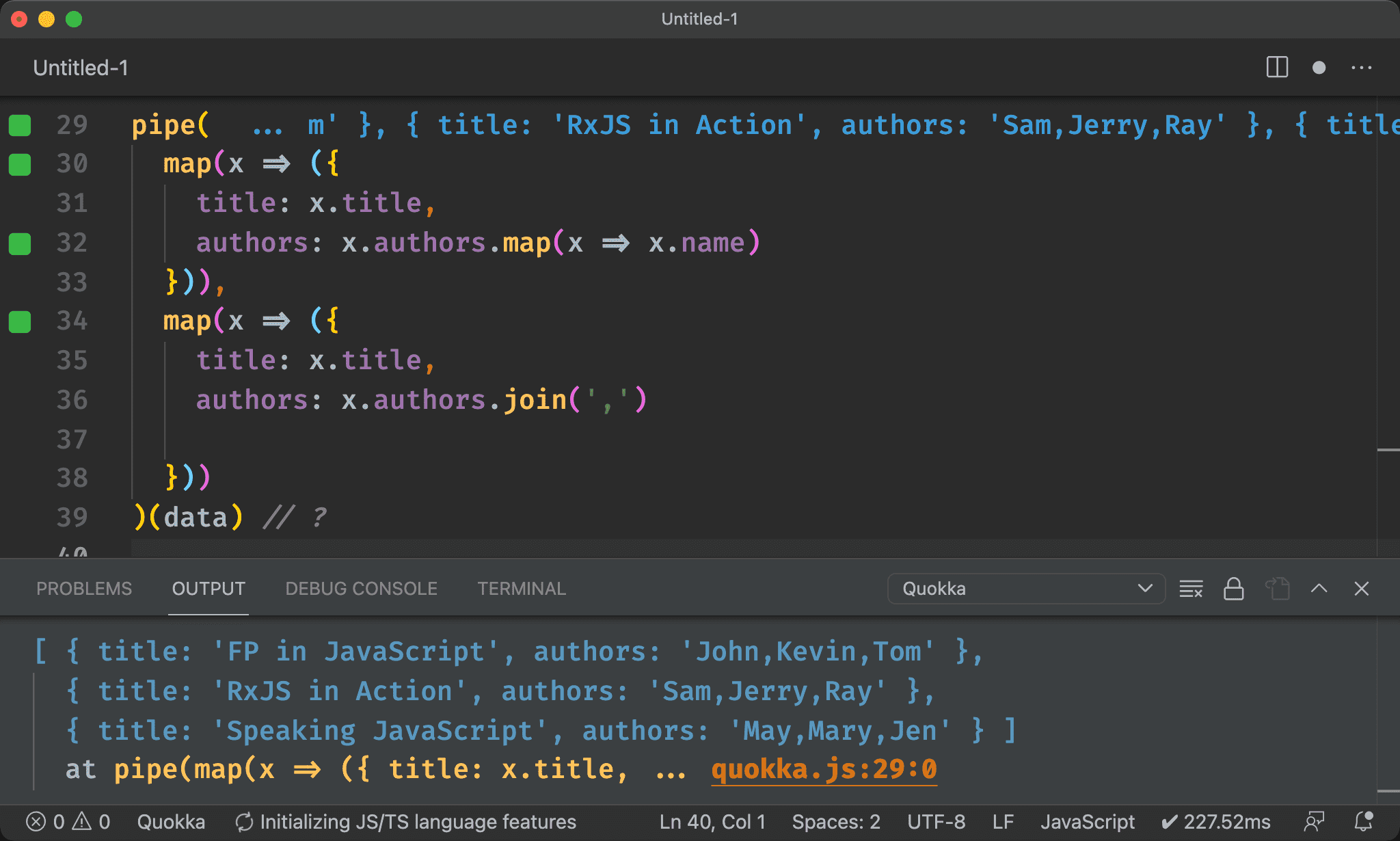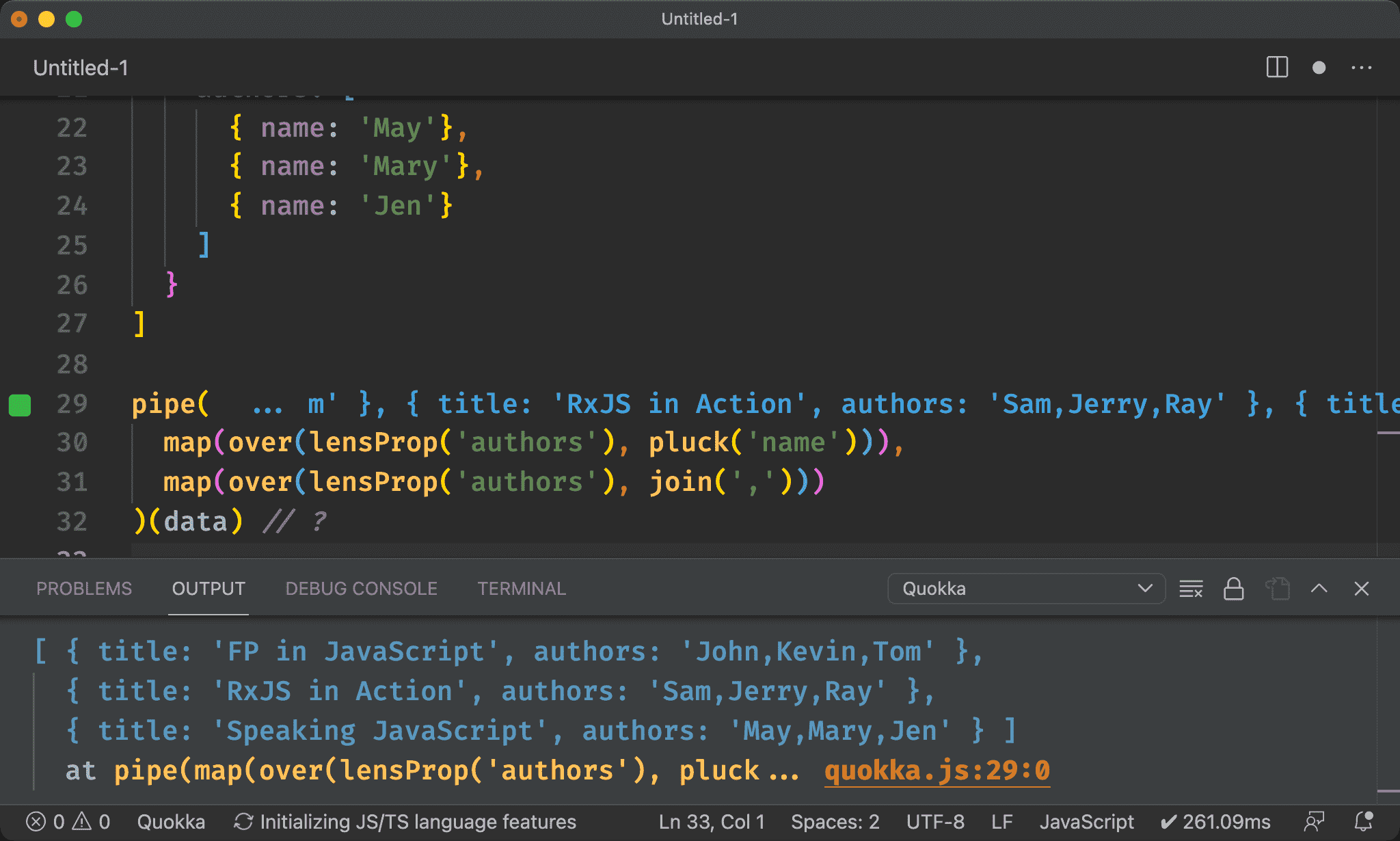實務上常遇到 API 回傳資料為 Nested Object Array,但卻要以 , 隔開的 String 顯示,這種常見需求該如何實現呢 ?
Version
Ramda 0.27.1
map()
import { pipe, map } from 'ramda'
let data = [
{
title: 'FP in JavaScript',
authors: [
{ name: 'John'},
{ name: 'Kevin'},
{ name: 'Tom'}
] },
{
title: 'RxJS in Action',
authors: [
{ name: 'Sam' },
{ name: 'Jerry' },
{ name: 'Ray' }
]
},
{
title: 'Speaking JavaScript',
authors: [
{ name: 'May'},
{ name: 'Mary'},
{ name: 'Jen'}
]
}
]
pipe(
map(x => ({
title: x.title,
authors: x.authors.map(x => x.name)
})),
map(x => ({
title: x.title,
authors: x.authors.join(',')
}))
)(data) // ?
第 3 行
let data = [
{
title: 'FP in JavaScript',
authors: [
{ name: 'John'},
{ name: 'Kevin'},
{ name: 'Tom'}
] },
{
title: 'RxJS in Action',
authors: [
{ name: 'Sam' },
{ name: 'Jerry' },
{ name: 'Ray' }
]
},
{
title: 'Speaking JavaScript',
authors: [
{ name: 'May'},
{ name: 'Mary'},
{ name: 'Jen'}
]
}
]
authors 是以 Object Array 型態存在,但卻希望以 String 顯示。
分兩階段處理:
- 先將 Object Array 轉成 Array
- 再將 Array 轉成 String
30 行
map(x => ({
title: x.title,
authors: x.authors.map(x => x.name)
})),
map():在map()中再使用Array.prototype.map()取出 Object Array 中的name成為單純 Array。
34 行
map(x => ({
title: x.title,
authors: x.authors.join(',')
}))
map():新資料筆數與原筆數相同,因此使用map()join():回傳仍是 Object,因此使用 arrow function 回傳 Object,authorsArray 使用Array.prototype.join(',')轉成 String

Point-free
import { pipe, map, lensProp, over, join, pluck } from 'ramda'
let data = [
{
title: 'FP in JavaScript',
authors: [
{ name: 'John'},
{ name: 'Kevin'},
{ name: 'Tom'}
] },
{
title: 'RxJS in Action',
authors: [
{ name: 'Sam' },
{ name: 'Jerry' },
{ name: 'Ray' }
]
},
{
title: 'Speaking JavaScript',
authors: [
{ name: 'May'},
{ name: 'Mary'},
{ name: 'Jen'}
]
}
]
pipe(
map(over(lensProp('authors'), pluck('name'))),
map(over(lensProp('authors'), join(',')))
)(data) // ?
30 行
map(over(lensProp('authors'), pluck('name')))
pluck('name'):先從 Object Array 取出name寫入authorsproperty 使之成單純 Array
亦可使用
map(prop('name')),但pluck('name')較精簡
31 行
map(over(lensProp('authors'), join(',')))
整個關鍵在於 join(',') 將 authors Array 轉成 String,但 join(',') 是 function 而非 value,有幾個 function 可考慮:
assoc():可直接修改authorsArray,但必須提供 value,因此並不適合set():可直接修改authorsArray,但必須提供 value,因此並不適合over():可直接修改authorsArray,但必須提供 function,因此可直接使用join(',')
唯 over() 需搭配 Lens,因此使用 lensProp('authors') 先建立 Lens,如此 map() 的 callback 可完全 Point-free。

Conclusion
- Ramda 有時很難一步完成,會先使用
map()達成階段性任務之後,再使用另外一個map()完成